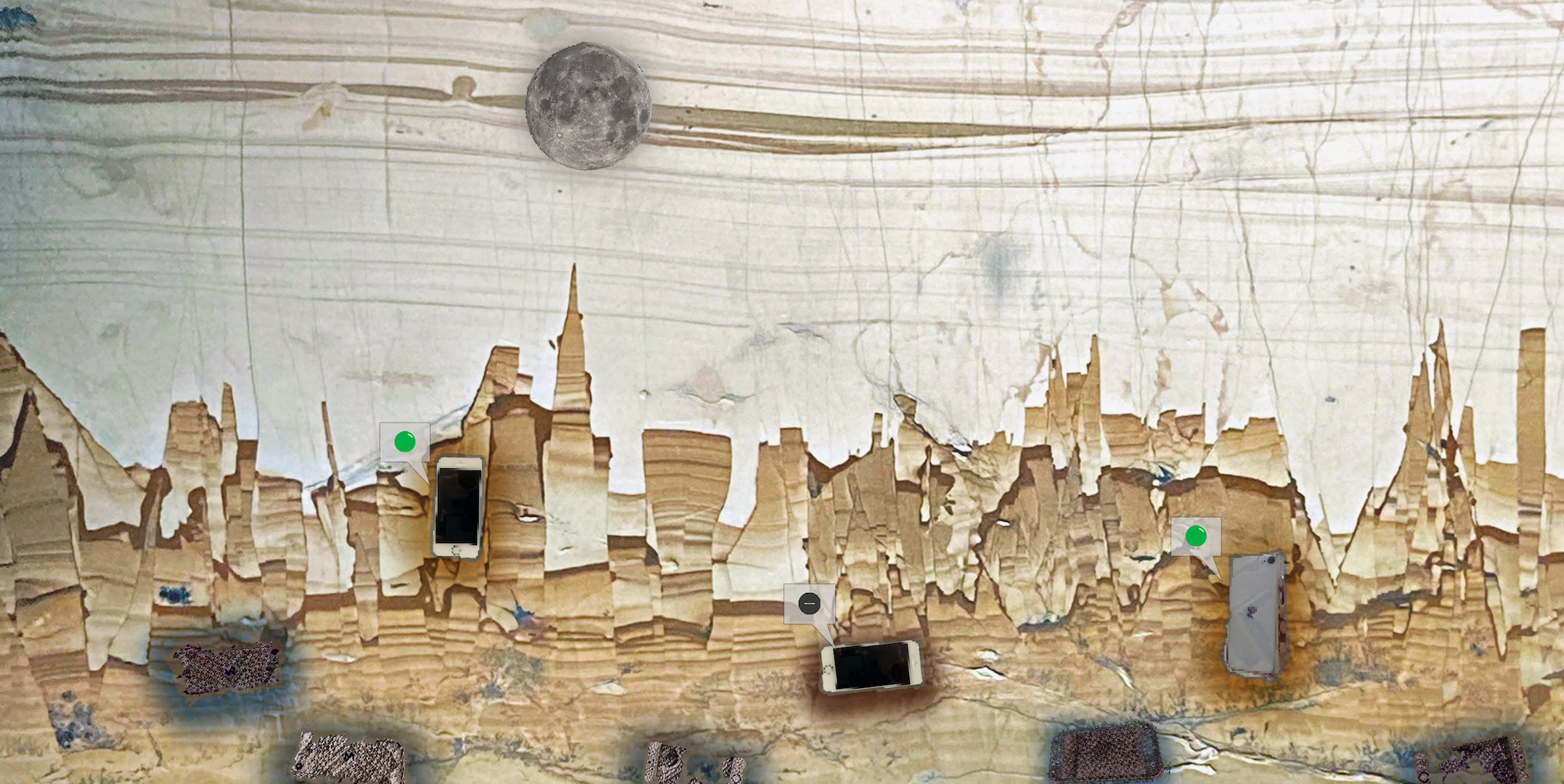
Lives of Your Smartphones
2022-Ongoing, Shinji Toya
[About the project]
The project aims to illustrate critically the speed and mode of production of the technological planned obsolescence today (i.e. artificially defined lifetime of technologies). It provides a type of caricature of the organic metaphor associated with the lifetime of electronic devices and the way in which the progress narrative of the current techno-capitalism can generate e-waste as “dead” (i.e. obsolete) devices.
The project provides a website, a browser-based artwork as an image-based participatory web archive. This archive displays photographs of smartphones submitted by the public, and the archive expands as more photographs are submitted.
The website appears as a kind of ruinous landscape. As participants submit the photographs of their smartphones online, the smartphone images will be made into a kind of life form to inhabit in the space of the landscape. However, their lifetime will end after a brief period. And they will become waste, decayed and fossilised eventually.
The project aims to make it visible that smartphones are materially connected to the soil. The materials of our smartphone such as rare earth elements were formed in the ground in the billions of years of geological time [1]. Furthermore, smartphones are also connected to the grounded global ICT network, the environment, and people and non-human beings that are connected to the environment. The damaging aspects of these connections can manifest through mining, smelting, informal recycling, e-waste disposal, pollution, health hazards among the workers of mining and e-waste management, biodiversity loss, and carbon emissions.
[1][2][3][4]
The world has already sold more than 10 billion smartphones [5]. On average, a smartphone’s lifespan ends in 4.7 years [2]. As of 2018, only 30% of electronics from the Western world were recycled through official routes [6]. Soon, where used smartphones are not recycled, their media waste can become archived in the ground, to cite Jennifer Gabrys. This sense of archive is made through the waste’s enduring, decaying materiality in landfills and the potentiality of future excavation. [7] Similarly, Jussi Parikka points to archival associations between the earth, media and its waste, and suggests that both media waste and the earth provide future (re-)readability [8].
The project speculatively gives a visible form to an archive of potential future media waste, as a fictitious landscape existing online that accumulates the photographs of smartphones. The artist critically places this speculative landscape as a reflection of the possible consequences of the accelerating, extractivist techno-capitalism. At the same time, the artist questions how we could move away from this mode of operation and vision.

[Preview of the website/archive]
> The first version of the work is to be shown at arebyte in their gallery in London between 27 October 2022 - 28 January 2023, in the exhibition Futures Past curated by arebyte.
> To submit the photograph of your smartphone, please visit HERE.
— References —
[1] Kate Crawford and Vladan Joler. 2018. Anatomy of an AI System: The Amazon Echo As An Anatomical Map of Human Labor, Data and Planetary Resources. AI Now Institute and Share Lab, https://anatomyof.ai [accessed 30 August 2022].
[2] Crawford, Kate. 2021. Atlas of AI: Power, Politics, and the Planetary Costs of Artificial Intelligence, Chapter 1: Earth. New Haven: Yale University Press.
[3] Bhowmik, Samir. 2021. ‘Lithium Landscapes: From Abstract Imaginaries to Deep Time and Multi-Scalar Topologies’. Media Fields Journal, Critical Explorations in Media and Space. http://mediafieldsjournal.org/lithium-landscapes/[accessed 21 October 2022].
[4] These damages manifest in countries including but not limited to Ghana, Nigeria, Pakistan, Mongolia, Indonesia, China, Australia, Chile and Bolivia. See [2] & [3], The Design Museum. 2021. ‘Exhibition Text on FADAMA 40 An Exploration of E-Waste, an Artwork by Ibrahimn Mahama, at Waste Age: What Can Design Do?’ and Ploeger, Dani et al. n.d. ‘Disobedient Devices - Waste’. Disobedient Devices. https://www.disobedientdevices.org/wastes [accessed 21 October 2022].
[5] ‘Electronics Industry’. 2022. In Wikipedia. https://en.wikipedia.org/w/index.php?title=Electronics_industry&oldid=1099458392 [accessed 30 August 2022].
[6] Formafantasma. 2019. Ore Streams - Visual Essay. https://vimeo.com/320151239 [accessed 30 August 2022].
[7] Gabrys, Jennifer. 2011. Digital Rubbish: A Natural History of Electronics. The University of Michigan Library. pp130-131.
[8] Parikka, Jussi. 2015. A Geology of Media. Electronic Mediations, volume 46. Minneapolis ; London: University of Minnesota Press. pp x-xi, p2, pp120-121, p127, p135, p138.
The project development was supported through London Creative Network, a programme by SPACE.
The project and the first version of the work were developed with the curatorial support of arebyte.
The project was informed by the research for the artist’s work co-commissioned by Phoenix and The Photographers’ Gallery for the exhibition Careful Networks.
With thanks to Ashwin D’Cruz for Machine Learning expertise and advice, and Noriko Okaku and Mamoru Watanabe for advice on technical development.
Thanks for the generous feedback on the project by Tanya Boyarkina and Sam Mercer.
The tools utilised for the project include:
- A photograph of the Ruin Marble specimen from the collections of the Natural History Museum, London
- Arbitrary Image Stylization AI model by Magenta and RunwayML
- ditherit.com
For queries, please contact Shinji Toya from info@shinjitoya.com